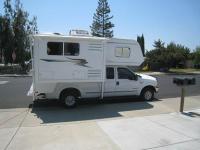HERR42, Thanks you for the information on your dual alternators. I see the Ford Service Manual accurately uses the term alternator and generator interchangeably. This might be confusing to some readers, but it is correct usage. It appears the two generators are charging on the same circuit. It is a neat setup. As you indicated, the objective seems to be increased charging capacity and a broad band of high output with the different size pulleys.
It is clever they way they use a power train control module (PCM) to turn the alternators on and off, facilitating the shutting down of one alternator (or both) when desired. With a single alternator the ignition switch frequently is used to turn on the alternator, disconnecting it when the ignition is turned off to prevent discharging the battery. Another way to prevent an alternator from discharging when the engine is stopped is by putting a diode in the output circuit. Marine applications often employ a diode because many are diesels with mechanical fuel injection pumps. These engines will run without any electronics. Their alternators can be entirely parasitic because some marine diesels are manually or hydraulic cranked, without electricals of any kind. (tractors too) The same approach could be used for a second alternator exclusively for the house circuit.
Using a second alternator with an internal regulator and a diode in the output circuit, there would be nothing except a single wire to the positive pole of the battery, no switching or control of any kind. If I’m not mistaken, the battery could be left connected to the alternator when charging from an external power source. I have not tried it, so I don’t know for sure. _John D

"Manual" Battery Isolator
Started by
Steve Scearce
, Sep 23 2009 02:45 PM
25 replies to this topic
#21

Posted 28 September 2009 - 12:59 AM
#22

Posted 28 September 2009 - 02:04 AM
HERR42, Thanks you for the information on your dual alternators. I read the quotes from the Ford Service Manual. As you say, it appears the two alternators are charging on the same circuit. It is a neat setup. I also agree, the objective here seems to be increased charging capacity and a broader band of high output on account of the two different size pulleys.
It is clever to use an electronic power train control module (PCM) to turn the alternators on and off, facilitating the shutting down of one alternator (or both) when desired. In older systems, the ignition switch does this job to prevent discharge through the alternator. Another way to prevent an alternator from discharging when the engine is stopped is by putting a diode in the output circuit. Some marine diesels and tractors run without electricity. Their alternators can be entirely parasitic, i.e., simpler. The same approach could be used for a second alternator in our truck campers, exclusively for the house circuit.
Using a second alternator with an internal regulator and a diode in the output circuit, there would be nothing except a single wire from the alternator to the positive pole of the battery, no switching or external control of any kind. If I’m not mistaken, the battery could be left connected to the alternator even when charging from an external power source. I have not tried it, so I don’t know for sure if this will work. _John D
It is clever to use an electronic power train control module (PCM) to turn the alternators on and off, facilitating the shutting down of one alternator (or both) when desired. In older systems, the ignition switch does this job to prevent discharge through the alternator. Another way to prevent an alternator from discharging when the engine is stopped is by putting a diode in the output circuit. Some marine diesels and tractors run without electricity. Their alternators can be entirely parasitic, i.e., simpler. The same approach could be used for a second alternator in our truck campers, exclusively for the house circuit.
Using a second alternator with an internal regulator and a diode in the output circuit, there would be nothing except a single wire from the alternator to the positive pole of the battery, no switching or external control of any kind. If I’m not mistaken, the battery could be left connected to the alternator even when charging from an external power source. I have not tried it, so I don’t know for sure if this will work. _John D
#23

Posted 28 January 2010 - 08:15 PM
You all got me worried now. Do I need to add something to my truck to keep from draining the batteries under the hood. I have a 1999 Ford F250 desiel. It already had a 7 round plug in the bed from the previous owner who towed a 5th wheel. Where I bought the cabover they added another one closer to the cab so now I have two in the bed. This doesn't count the one at the back at the hitch receiver. Anyway, anyone know if it should already have an isolator or do I need to put one on.
Dave
Dave
#24

Posted 28 January 2010 - 10:55 PM
10 ga wire runs about an ohm per thousand feet. that 7 pin rv plug is specifically designed to charge a battery in a towable. and it will do a good job and fully charge a battery.
but, for a camper its not a good solution.
look over how ATC,FWC do theirs and copy the approach....it is a good one.
Why do you say it is a good to charge a towable but not a camper?
Granby on an F250 in S. NM
#25

Posted 30 January 2010 - 06:44 PM
Why do you say it is a good to charge a towable but not a camper?
i think that you can connect anything you want but i also believe that anything connected should provide a mechanism to isolate itself from the vehicle and not provide a discharge path. unless the vehicle charging system is active.
if the camper has an isolator than its ok by me.
tapping into the RV plug circuit would preclude its use with a towable while the camper is connected.
using a seperate line to the vehicle battery , like the manf does, seems to be the best bet.
another issue is that the camper battery should not be allowed to attempt to contribute toward vehicle starting current. its 10gauge wiring cant handle that.
Jeff Herr WW6L
'07 Hawk & '00 F250 SuperDuty CrewCab, Warn 12K, BFG AT KO 'E' rated, TransferFlow 48Gal tank
#26

Posted 31 March 2010 - 02:13 AM
I use a continuous duty solenoid for twenty years to isolate my batteries. It's simple, cheap, and doesn't require me to remember to unhook it.
Until you can isolate the batts, your solution sounds like a reasonable one, so long as you're not discharging your battery below 12 volts. And remember that it will take your alternator HOURS (like 20-25) to fully charge a battery that is fully discharged, and it's pretty tough on your alternator. Buy a cheap digital volt/ ohmmeter at Harbor Freight and CHECK your voltage each morning so you have an idea what your battery's condtion is.
Frank
Until you can isolate the batts, your solution sounds like a reasonable one, so long as you're not discharging your battery below 12 volts. And remember that it will take your alternator HOURS (like 20-25) to fully charge a battery that is fully discharged, and it's pretty tough on your alternator. Buy a cheap digital volt/ ohmmeter at Harbor Freight and CHECK your voltage each morning so you have an idea what your battery's condtion is.
Frank
What part of "shall not be infringed" don't you understand?
0 user(s) are reading this topic
0 members, 0 guests, 0 anonymous users


















